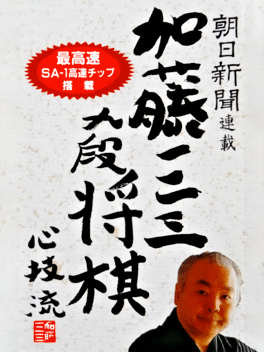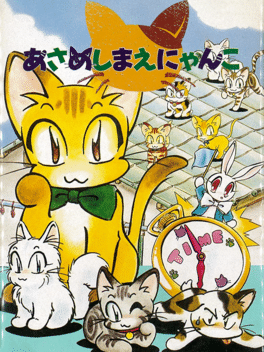Most Popular Super Famicom Games - Page 11
-
Super Real Mahjong PV Paradise: All-Star 4-nin Uchi
1995
Part of SETA Corporation's series of mahjong games featuring a recurring cast of anime women. PV Paradise is a Super Famicom-exclusive entry. -
Shin SD Sengokuden: Daishogun Retsuden
1995
A turn-based strategy game based on Shin SD Sengokuden, an anime spin-off of an anime spin-off. -
Asahi Shinbun Rensai: Katou Hifumi Kudan Shogi Shingiryuu
1995
An educational shogi game for the Super Famicom endorsed by Asahi Shimbun, one of Japan's major national newspapers and Katou Hifumi, a professional 9th Dan player. -
Zero-4 Champ RR-Z
1995
Zero-4 Champ RR-Z
1995
A drag racing game based on the illegal "zero-4" street race. The second of two Super Famicom games in the series. -
Madara Saga: Youchien Senki Madara
1996
A comedic adaptation of the Madara anime and manga that reimagines the demon hunter heroes as rambunctious kindergartners. -
Table Game Daishuugo!!
1996
A board game compilation for the Super Famicom. It features virtual versions of mahjong, shogi, reversi and two hanafuda variants. -
Furuta Atsuya no Simulation Pro Yakyuu 2
1996
A baseball game and the sequel to 1995's Simulation Pro Yakyuu. Features the name and likeness of Atsuya Furuta, catcher for the Yakult Swallows. -
Bishoujo Senshi Sailor Moon Sailor Stars: Fuwa-fuwa Panic 2
1996
Bishoujo Senshi Sailor Moon Sailor Stars: Fuwa-fuwa Panic 2 is a video game released exclusively in Japan by Bandai on September 27, 1996. the Super Famicom and is the sequel to Sailor Moon SuperS: Fuwa Fuwa Panic. The game made use of Bandai's SuFami Turbo accessory and could not be played without it. -
Battle Dodgeball: Toukyuu Daigekitotsu!
1991
Battle Dodge Ball is a part of the Japanese exclusive Compati Hero Series. Gundam, Kamen Rider V3, and Ultraman Taro are the main representatives of the 'heroes' side of the six teams in Battle Dodge Ball, with Zeong, Ika Devil, and Zetton rounding out as the villains. The general gist of the game is that you can choose one of the six teams. You then fight each of the other five teams once per round in a short dodgeball game, two-on-two. Unlike normal dodgeball, you are not knocked out with a single hit. Rather, in Battle Dodge Ball, each character has a specific amount of HP. Once he takes enough hits to lose all his HP, he is out of the match. The game also adds an RPG element in the ability to gain experience at the end of a match, win or lose, which can then be used to power up stats of your team's players. -
Bishoujo Senshi Sailor Moon R
1993
Bishoujo Senshi Sailor Moon R is a video game released for the Super Famicom by Bandai in 1993. It serves as a sequel to Bishoujo Senshi Sailor Moon. Upon starting the game, the player can choose one of 5 characters (2 can be selected for co-op). The game is divided into four levels; each level being divided further into two sub-levels. The player will fight numerous enemies, mostly consisting of default Droids based on their manga incarnations. At the end of each level, a boss must be defeated to proceed. Pressing a special button makes the character use a devastating attack that kills all lesser enemies on screen and causes significant damage to a boss character, although the use of the attack is limited. Bonus items can be picked up from the ground or found in breakable objects, usually in the form of food items that replenishes the life meter to varying degrees. Chibiusa Mode is synonymous with an "Easy Mode". Chibiusa's sprite is too short to be hit by most attacks, and the enemies are also made easier to b -
Super Rugby
1994
Super Rugby
1994
Super Rugby is a Sports game, developed by Zap and published by TSS, which was released in Japan in 1989. -
F-1 Grand Prix
1992
F-1 Grand Prix
1992
F-1 Grand Prix is a 1991 Formula One-based arcade racing video game developed and published by Video System exclusively in Japan. It is the first title in Video System's licensed F1 Grand Prix series, which this title is based on the 1991 Formula One season. It was licensed by Fuji Television and FOCA. The arcade game was later ported to the Super Famicom exclusively in Japan on April 28, 1992. -
Super Pachinko
1994
Super Pachinko
1994
Super Pachinko is a Miscellaneous game, developed by Betop and published by I'Max, which was released in Japan in 1994. -
Shin Nekketsu Kouha Kunio-kun: Kunio-tachi no Banka
1994
Shin Nekketsu Kōha Kunio-kun: Kunio-tachi no Banka is a beat 'em up in the Kunio / Nekketsu High series. The eternal rebel Kunio and his pal Riki finally get to face the long arm of the law when they get both arrested for killing a couple of bystanders in a hit-and-run incident. Problem is they are innocent and the lookalike killers are still out there! Kunio and his pal now have to break out of the prison and go kick some butt in the name of justice (and to clear their names of course). Gameplay involves defeating all opponents using your arsenal of attacks and special moves and completing the many side scrolling stages that make up the game, usually after beating an end level boss. Kunio and Riki are not alone in their quest, as their hard boiled girlfriends, Misako and Kyoko, can join up and provide their unique collection of special moves to the mix. Biking sequences in which you try to get to another part of town while fending-off opponents Road Rash-style are also added for additional gameplay and the gam -
Drift King Shuto-kou Battle 2: Tsuchiya Keiichi & Bandou Masaaki
1995
Drift King Shuto-kou Battle 2 is a behind-the-car driving game exclusive to the Super Famicom. It is named after and endorsed by Keiichi "Drift King" Tsuchiya, and the title refers to the Shuto Expressway near Tokyo upon which most of the races take place. Players select a car and customize it before taking it to the track to race against other street racing enthusiasts. The game maintains a split-screen regardless of whether or not a second player is involved; on single-player, the top screen's camera stays on the starting line. -
Leading Company
1993
Leading Company
1993
The traditional definition of a leading company is a corporation that currently dominates the "corporate wars" against their competitors. Its employees are considered by most people to be winning the "rat race." The game challenges young people to create their own business empire by researching and marketing better VHS machines for the Japanese consumers. The player is introduced to jazzy instrumental song being played in the background while neon pictures of various people fly across the screen. As of 2011, there has been no attempt to produce an English language version for this game either through official channels or through unofficial emulator translator groups. This game is considered to be in Japanese for the full duration of the game, making literacy skills in Japanese mandatory. Only the brand names themselves use ASCII letters; all other words use the Japanese alphabet. There are only two time periods in the game and jazz music plays throughout the entire game. -
America Oudan Ultra Quiz
1992
Japan-exclusive quiz game based on a TV game show. It is the fourth game in the American Oudan Ultra Quiz series. Featuring 3000 questions, aim to become the Quiz King! -
Funaki Masakatsu Hybrid Wrestler: Tougi Denshou
1994
The sport of wrestling mixed with real life simulation! Funaki Masakatsu of Pancrase has shaped the new, most unique wrestling game ever made, and its up to you to make wrestling history! Create your character, control his stats and take your place in the highest rank of wrestling! -
Asameshimae Nyanko
1994
Asameshimae Nyanko
1994
Asameshimae Nyanko has similarities with Reversi (or Othello) and with fights that are similar to rock-paper-scissors to intercept additional moves with kittens that have different proficiency with vertical/horizontal and diagonal moves. In the game, players partake in a Reversi-esque game and get to choose a number of stages to play on and the type of kitten they want to use. They can also change the rules and settings to an extent. It's red versus blue, with a random player going first. As players would in Reversi or Othello, sandwich kittens vertically, horizontally or diagonally (though since the game is isometric, it's hard to say vertically or horizontally). They will change all the kittens in between to a certain color, but can additionally select cats in the area to do battle with. Winning allows players to further convert cats to their cause. There are special items which have certain effects such as making players lose a turn, but, there isn't much interruption from them. -
Bakutou Dochers: Bumps-jima ha Oosawagi
1994
Bakutou Dochers is a Japan-only action game for up to four players. It superficially resembles Hudson's Bomberman series, with its top-down grid stages and chaotic gameplay, but rather than leaving bombs and waiting for them to explode, the player can shoot energy at blocks and each other. The goal is to sneak up behind the opponent and shoot them before they can reciprocate. Various power-ups may appear after destructible blocks are removed, which can give the player an edge or, in the case of the ? icon, a possible random negative effect like reversed controls. There are also wandering monsters that can cause damage to anyone they come in contact with. Every combatant has a health bar which depletes at a rate dependent on the attacks they are getting hit by. The single-player mode involves fighting through various worlds and removing all enemy combatants from the field to progress.



















